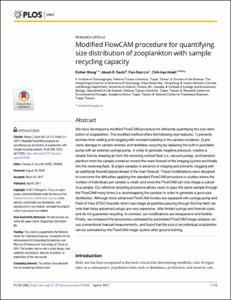| dc.contributor.author | Wong, Esther | |
| dc.contributor.author | Sastri, Akash R. | |
| dc.contributor.author | Lin, Fan-Sian | |
| dc.contributor.author | Hsieh, Chih-hao | |
| dc.date.accessioned | 2023-07-21T17:14:53Z | |
| dc.date.available | 2023-07-21T17:14:53Z | |
| dc.date.issued | 2017 | |
| dc.identifier.citation | Wong, E., Sastri, A.R., Lin, F-S. and Hsieh, C-h
(2017) Modified FlowCAM procedure for
quantifying size distribution of zooplankton with
sample recycling capacity. PLoS ONE ,12(4):
e0175235, 12pp. DOI: https://doi.org/10.1371/journal.
pone.0175235 | en_US |
| dc.identifier.uri | https://repository.oceanbestpractices.org/handle/11329/2326 | |
| dc.description.abstract | We have developed a modified FlowCAM procedure for efficiently quantifying the size distribution
of zooplankton. The modified method offers the following new features: 1) prevents
animals from settling and clogging with constant bubbling in the sample container; 2) prevents
damage to sample animals and facilitates recycling by replacing the built-in peristaltic
pump with an external syringe pump, in order to generate negative pressure, creates a
steady flow by drawing air from the receiving conical flask (i.e. vacuum pump), and transfers
plankton from the sample container toward the main flowcell of the imaging system and finally
into the receiving flask; 3) aligns samples in advance of imaging and prevents clogging with
an additional flowcell placed ahead of the main flowcell. These modifications were designed
to overcome the difficulties applying the standard FlowCAM procedure to studies where the
number of individuals per sample is small, and since the FlowCAM can only image a subset
of a sample. Our effective recycling procedure allows users to pass the same sample through
the FlowCAM many times (i.e. bootstrapping the sample) in order to generate a good size
distribution. Although more advanced FlowCAM models are equipped with syringe pump and
Field of View (FOV) flowcells which can image all particles passing through the flow field; we
note that these advanced setups are very expensive, offer limited syringe and flowcell sizes,
and do not guarantee recycling. In contrast, our modifications are inexpensive and flexible.
Finally, we compared the biovolumes estimated by automated FlowCAM image analysis versus
conventional manual measurements, and found that the size of an individual zooplankter
can be estimated by the FlowCAM image system after ground truthing. | en_US |
| dc.language.iso | en | en_US |
| dc.rights | Attribution 4.0 International | * |
| dc.rights.uri | http://creativecommons.org/licenses/by/4.0/ | * |
| dc.subject.other | Sampling | en_US |
| dc.title | Modified FlowCAM procedure for quantifying size distribution of zooplankton with sample recycling capacity. | en_US |
| dc.type | Journal Contribution | en_US |
| dc.description.refereed | Refereed | en_US |
| dc.format.pagerange | 12pp. | en_US |
| dc.identifier.doi | https://doi.org/10.1371/journal. pone.0175235 | |
| dc.subject.parameterDiscipline | Zooplankton | en_US |
| dc.subject.dmProcesses | Data acquisition | en_US |
| dc.bibliographicCitation.title | PLoS ONE | en_US |
| dc.bibliographicCitation.volume | 12 | en_US |
| dc.bibliographicCitation.issue | 4 ( e0175235) | en_US |
| dc.description.sdg | 14.a | en_US |
| dc.description.maturitylevel | Pilot or Demonstrated | en_US |
| dc.description.adoption | Novel (no adoption outside originators) | en_US |
| dc.description.adoption | National | en_US |
| dc.description.sensors | Flowcam | en_US |
| dc.description.methodologyType | Method | en_US |
| dc.description.methodologyType | Specification of criteria | en_US |
| obps.contact.contactname | Chih-hao Hsieh | |
| obps.contact.contactemail | chsieh@ntu.edu.tw | |
| obps.resourceurl.publisher | https://journals.plos.org/plosone/article?id=10.1371/journal.pone.0175235 | |
 Repository of community practices in Ocean Research, Applications and Data/Information Management
Repository of community practices in Ocean Research, Applications and Data/Information Management

